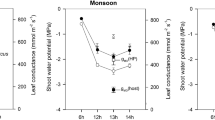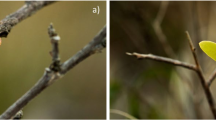Abstract
Parasitism of plants by other plants provides an exceptional opportunity for investigating correlative nutritional relationships. Because of lacking a usual plant-root sytem capable of active uptake, the best correlation for predicting the concentrations of elements in parasitic plants is often those in the host plants. This study, therefore, mainly focuses on determination of i) mineral nutrient partitioning between hemi-parasitic white berry mistletoe (Viscum album L. subsp. album) and four of its deciduous hosts growing in different habitats namely wetland and semi-arid and ii) effects of these habitat types on nutrient absorption. During the research, leaf samples of both hemi-parasites and their host plants were chemically analysed, mistletoes on each host plants were counted and the results were considered statistically. Concentrations of some elements (N, P, K, Na, S, Cu, Zn) were higher in mistletoe whereas some others (Ca, Mg, Fe, Mn and B) were higher in the hosts (p< 0.05). Habitat type was also determined to be effective in host-parasite systems. Revealing information about nutritional interactions between multi-host hemi-parasites and their host plants is a useful tool to understand their functions in ecosystems, population-community dynamics and their co-evolution process.
Similar content being viewed by others
References
Amico G.C. & Aizen M.A. 2000. Mistletoe seed dispersal by a marsupial. Nature 408: 929–930.
Anonymous, 1994. Soil Laboratory Tecniques, Turkish Forest Ministry. Eskişehir Forest Soil Ecology Research Laboratory, Eskişehir, Turkey.
Anonymous, 2007. Eskişehir Meteorology Station, Eskişehir, Turkey.
Bannister P. 1989. Nitrogen concentration and mimicry in some New Zealand mistletoes. Oecologia 79: 128–132.
Barney C.W., Hawksworth F.G. & Geils B.W. 1998. Hosts of Viscum album. Eur. J. For. Path. 28: 187–208.
Black C.A. 1965. Methods of soil analyses. American Society of Agronomy, Inc. Publisher, Madison, Wisconsin, USA.
Bowie M. & Ward D. 2004. Water and nutrient status of the mistletoe Plicosepalus acaciae parasitic on isolated Negev desert populations of Acacia raddiana differing in level of mortality. J. Arid. Environ. 56: 487–508.
Brayshay B.A. & Dinnin M. 1999. Integrated palaeoecological evidence for biodiversity at the floodplain-forest magrin. J. Biogeography 26: 115–131.
Brown P.H. & Shelp B.J. 1997. Boron mobility in plants. Plant Soil 193: 85–101.
Cireli B., Seçmen Ö. & Öztürk M. 1983. Bitki ekolojisi uygulamalar? (Applications of plant ecology), Ege üniv. Fen Fak. Kitaplar Serisi No: 51, Bornova-İzmir.
Classius C. 1601. Caroli clusi at rebatis. rariorum plantarum historia, Antwerp, Belgium.
Davies D.M. & Graves J.D. 2000. The impact of phosphorus on interactions of the hemi-parasitic angiosperm Rhinanthus minor and its host Lolium perenne. Oecologia 124: 100–106.
de Buen L. & Ornelas J. 2001. Seed dispersal of the mistletoe Psittacanthus schiedeanus by birds in central Veracruz, Mexico. Biotropica 33: 487–494.
Devkota M.P. 2005. Biology of mistletoes and their status in Nepal Himalaya. Himalayan J. Sci. 3: 85–88.
Dobbertin M. & Rigling A. 2006. Pine mistletoe (Viscum album ssp. austriacum) contributes to Scots pine (Pinus sylvestris) mortality in the Rhone valley of Switzerland. Forest Pathol. 36: 309–322.
Doi H., Yurlova N.I., Vodyanltskaya S.N., Klkuchi E., Shikano S., Yadrenkina E.N. & Zuykova E.I. 2008. Parasite-induced changes in nitrogen isotope signatures of host tissues. J. Parasitol. 94: 292–295.
Ehleringer J.R. & Schulze E.D. 1985. Mineral concentrations in an autoparasitic Phoradendron californicum growing on a parasitic P. californicum and its hosts, Cercidium floridum. Am. J. Bot. 72: 568–571.
Emberger L. 1952. Sur le quotient pluviother migse. C.R. Acad. Sci. 234: 2508–2510.
Erdir M. & Türe C. 2003. Plant diversity and general ecological characteristics of a protected area of MusaÖzü dam and its environment (Eskisehir, Turkey). Anadolu University, J. Sci. Technol. 4: 301–322.
Fischer J.T. 1983. Water relations of mistletoes and their hosts. In: Calder M. & Bernhardt P., (eds), The biology of mistletoes, Academic Pres, San Diego, CA.
Garkoti S.C., Akoijam S.B. & Singh S.P. 2002. Ecology of water relations between mistletoe (Taxillus vestitus) and its host oak (Quercus floribunda). Tropic. Ecol. 43: 243–249.
Gathumbi S.M., Bohlen P.J. & Graetz D.A. 2005. Nutrient enrichment of wetland vegetation and sediments in subtropical pastures. Soil Sci. Soc. Am. J. 69: 539–548.
Gauslaa Y. & Odasz A.M. 1990. Water relations, temperatures, and mineral nutrients in Pedicularis dasyantha (Scrophulariaceae) from Svalbard, Norway. Holarctic Ecology 13: 112–121.
Glatzel G. 1983. Mineral nutrition and water relations of hemiparasitic mistletoes: a question of partitioning. Experiments with Loranthus europaeus on Quercus petraea and Quercus robur. Oecologia 56(2–3): 193–201.
Glatzel G. & Geils B.W. 2009. Mistletoe ecophysiology: hostparasite interactions. Botany 87: 10–15.
Gülçur F. 1974. Topraǧın Fiziksel ve Kimyasal Analiz Metodlar? (Physical and Chemical Analysis Methods of Soil), İstanbul üniversitesi Orman Fak. Yay., İ.Ü, Yay. No: 1970, O.F. Yay. No: 201, İstanbul.
Hellmuth E.O. 1971. Eco-physiological studies on plants in arid and semi-arid regions in Western Australia, IV. Comparison of the field physiology of the host, Acacia grasbyi and its hemiparasite, Amyema nestor under optimal and stress conditions. J. Ecol. 59: 351–363.
Hosseini S.M., Kartoolinejad D., Mirnia S.K., Tabinzadeh Z., Akbarinia M. & Shayanmahr F. 2008a. The effects of Viscum album L. on foliar weight and nutrients content of host trees in Caspian forests (Iran). Polish J. Ecol. 55: 579–583.
Hosseini S.M., Kartoolinejad D., Mirnia S.K., Tabinzadeh Z., Akbarinia M. & Shayanmahr F. 2008b. The European mistletoe effects on leaves and nutritional elements of two host species in Hyrcanian forests. Silvia Lusitana 16: 229–237.
Kroll H. 1998. Literature on archaeological remains of cultivated plants (1996/1997). Veget Hist Archaeobot. 7: 23–56.
Kutbay H.G., Karaer F. & Kilinç M. 1996. The relationships of some nutrients between Cuscuta epipthymum (L.) L. var. epithymum and Heliotropium europaeum L. Tr. J. Bot. 20: 515–518.
Ladley J.J. & Kelly D. 1995. Explosive New Zealand mistletoes. Nature 378: 766.
Lamien N., Boussim J.I., Nygarad R., Ouédraogo J.S., Odén P.C. & Guinko S. 2006. Mistletoe impact on Shea tree (Vitellaria paradoxa C.F. Gaertn.) flowering and fruiting behaviour in savanna area from Burkina Faso. Environ. Exp. Bot. 55: 142–148.
Lamont B. 1983. Mineral nutrition of mistletoes, pp. 185–204. In: Calder M. & Bernhardt P. (eds), The Biology of Mistletoes, Academic Press, New York.
Malicki L. & Berbeciowa C. 1986. Content of basic macroelements in common parasitical weeds. Acta Agrobot. 39: 123–128.
Malone M., White P. & Morales M.A. 2002. Mobilization of calcium in glasshouse tomato plants by localized scorching. J. Exp. Bot. 53: 83–88.
Marshall J.D. & Ehleringer J.R. 1990. Are xylem-tapping mistletoes partially heterotrophic? Oecologia 84: 244–248.
Marshall J.D., Ehleringer J.R., Schulze E.D. & Farquhar G. 1994. Carbon isotope composition, gas exchange, and heterotrophy in Australian mistletoes. Funct. Ecol. 8: 237–241.
Marvier M.A. 1996. Parasitic plant-host interactions: Plant performance and indirect effects on parasite-feeding herbivores. Ecology. 77: 1398–1409.
Mathiasen R.L., Nickrent D.L., Shaw D.C. & Watson D.M. 2008. Mistletoes — Ecology, systematics, ecology and management. Plant Disease 92: 987–1006.
Mehrotra R.S. 1978. Plant pathology. Mc-Graw-Mill, New Delhi.
Miura O., Kuris A.M., Torchin M.E., Hechinger R.F. & Chiba S. 2006. Parasites alter host phenotype and may create a new ecological niche for snail hosts. Proceed. Royal Society B 273: 1323–1328.
Norton D.A., Ladley J.J. & Owen H.J. 1997. Distribution and population structure of the loranthaceous mistletoes Alepis flavida, Peraxilla colensoi and Peraxilla tetrapetala within two New Zealand Northofagus forests. NZ J. Bot. 35: 323–336.
Novacek F. 1985. Mineral deficiency in forest woody plants caused by giant mistletoes (Loranthus europaeus Jacq.) and European mistletoe (Viscum album Boiss. & Reut.) Lesnictvi, Cesk. Akad. Zemed. Ustav. Vedeckotech. Inf. Zemed. 31: 145–154.
Pegeau K., Simier P., Bizec B., Robins R. & Fer A. 2003. Characterization of nitrogen relationships between Sorghum bicolor and the root-hemiparasitic angiosperm Striga hermonthica /Del.) Benth. using K15NO3 as isotopic tracer. J. Exp. Bot. 54: 383, 789–799.
Pres M.C. & Phoenix G.K. 2005. Impacts of parasitic plants on natural communities. New Phytol. 166: 737–751.
Puustinen S. & Mutikainen P. 2001. Host-parasite-herbivore interactions: implications of host cyanogenesis. Ecology 82: 2059–2071.
Richter A., Popp M., Mensen R., Stewart G.R. & von Willerat D.J. 1995. Heterotrophic carbon gain of the parasitic angiosperm Tapinanthes oleifolius. Aust. J. Plant Physiol. 22: 537–544.
RÖdl T. & Ward D. 2002. Host recognition in a desert mistletoe: early stages of development are influenced by substrate and host origin. Functional Ecology 16: 128–134.
Schulze E.D., Turner N.C. & Glatzel G. 1984. Carbon, water and nutrient relations of two mistletoes and their hosts: A hypothesis. Plant, Cell & Environ. 7: 293–299.
Smith S. & Stewart G.R. 1990. Effect of potassium levels on the stomatal behaviour of the hemiparasite Striga hermonthica. Plant Physiol. 94: 1472–1476.
Soto-Gamboa M. & Bozinovic F. 2002. Fruit-disperser interaction in a mistletoe-bird system: A comparison of two mechanisms of fruit processing on seed germination. Plant Ecol. 159: 171–174.
Tsopelas P., Angelopoulos A., Economou A. & Soulioti N. 2004. Mistletoe (Viscum album) in the fir forest of Mount Parnis, Greece. Forest Ecol. Manag. 202: 59–65.
Türe C., Bingöl N.A. & Middleton B. 2004. Characterization of the habitat of Lythrum salicaria L. in floodplain forests in western Turkey-Effects on the stem height and seed production. Wetlands. 24: 711–716.
Türe C. & Böcük H. 2007. An investigation on the diversity, distribution and conservation of Poaceae species growing naturally in Eskişehir province (Central Anatolia-Turkey), Pak. J. Bot. 39: 1055–1070.
Umucalilar H.D., Gülşen N., Coşkun B., Hayirli A. & Dural H. 2007. Nutrient composition of mistletoe (Viscum album) and its nutritive value for ruminant animals. Agroforest Syst. 71: 77–87.
Walter H. & Lieth 1960. Kilemediagramm-Weltatlas, Fischer, Jena.
Watson D.M. 2001. Mistletoe — A keystone resource in forest and woodlands worldwide. Annu. Rev. Ecol. System 32: 219–250.
Yoder J. 2001. Host-plant recognition by parasitic Scrophulariaceae. Current Opinion in Plant Biology 4: 359–365.
Yüksel B., Akbulut S. & Keten A. 2005. The damage, biology and control of pıne mistletoes (Viscum album ssp. austriacum (Wiesb.) Vollman), Süleyman Demirel University. J. of Forest Faculty A2: 111–124.
Zuber D. 2004. Biological flora of Central Europe: Viscum album L. Flora 199: 181–203.
Author information
Authors and Affiliations
Corresponding author
Rights and permissions
About this article
Cite this article
Türe, C., Böcük, H. & Aşan, Z. Nutritional relationships between hemi-parasitic mistletoe and some of its deciduous hosts in different habitats. Biologia 65, 859–867 (2010). https://doi.org/10.2478/s11756-010-0088-5
Received:
Accepted:
Published:
Issue Date:
DOI: https://doi.org/10.2478/s11756-010-0088-5




